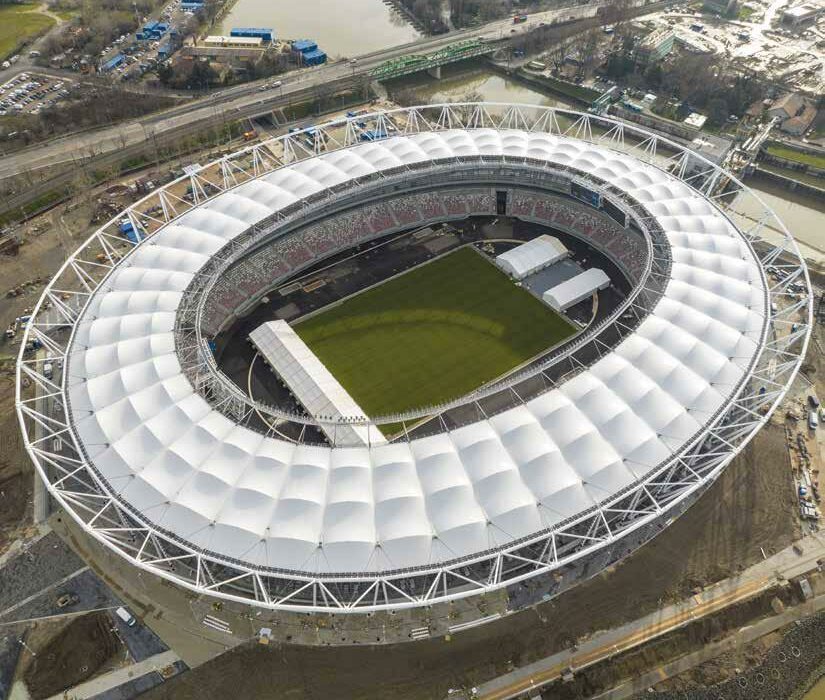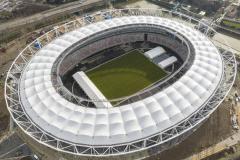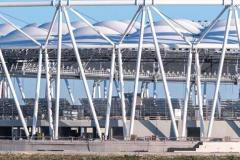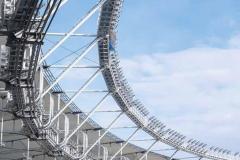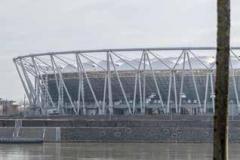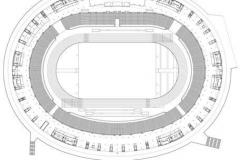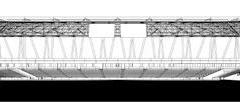Global City Pergola
Athletic Stadium, Budapest
Text: György Szegő
Architects: Marcel Ferencz, György Détári
Photos: György Palkó
The development of the National Athletics Centre is to connect the northern and southern areas of the entire Pest quay for thosa walking, travelling by bicycle (and by the river using the harbour). The three-level facility is located in the heart of the new 15-hectare sports park: the media centre and the athletes’ and service areas are accessible from the city side of the stadium at the bottom, the main level of the public communication zone is connected to the bank of the River Danube at the front, whilst the temporary grandstand is located on the upper level, which is to be replaced by the new leisure, recreation and civilian rehabilitation sports function after the World Championships. The permanent grandstand is going to have a seating capacity of 15,000 spectators, whilst the upper mobile stands set up for the world events will accommodate an additional 25,000 people. The entire building is powered by renewable energy. The semi-covered semi-open structure functions almost like an urban pergola sheltering the open sports ring and fields below, from where runners living in the city can watch professional sports events and also enjoy the panoramic views while doing some sports. The almost antique charm of the stadium is precisely due to the transparency of the seemingly lightweight but robust supporting structure made of steel. The generous cloud-effect roofing also covers the mobile grandstands. Full coverage in both modes provides an impressive framework for the transparency which is the very essence of the building. The airy quality also allows for a magnificent view of the River Danube and the developments on the opposite bank. Details are both subtle and dynamic, creating a genuinely contemporary beauty of structure.
General architecture: Napur Architect Kft.
Leading architect: Marcel Ferencz DLA
General architect: György Détári DLA
Project management: Gergely Filó, Viktor Fikó
Fellow architects: Pál Holyba, Dávid Nyul, Csaba Grócz, Mónika Mészáros, Réka Kovács, Kinga Koralevicz, Tamás Poros, Norman Kakas, Márk Horváth, Márk Mészáros
Framework: László Gábor Szántó
Structure: Richárd Reisch
HVAC: Attila Lucz
Electrical engineering: Zoltán Ivanics
Building automatisation: László Harmath
Fire protection: György Decsi
Garden, landscape: Tamás Sándor, Hanna Polereczkiné Matécsa
Roads, traffic: Klára Macsinka PhD Dr
Accessibility: András Pandula
Town-planning: István Kotsis
Acoustics: Róbert Csott
Medicine technology: Károly Tóth
Sports technology: László Erdei
Kitchen technology: András Gauland
Environment protection: Attila Jenei
Geotechnology: László Szilvágyi, Balázs Burghardt
BREEAM: Borbála Cross-Boda
Budget: Ágoston Szabó
Outdoor public utilities: László Tóth Dr.
Bridges, underpass: Gábor Pál
Main contractor: ZÁÉV Ltd., Magyar Építő Ltd.
